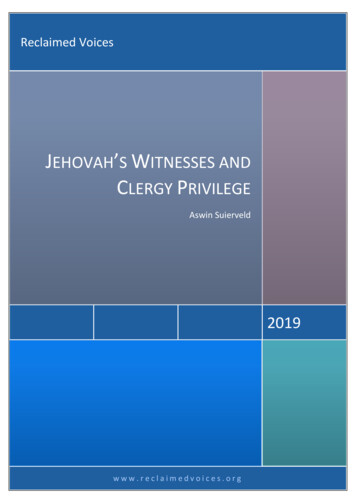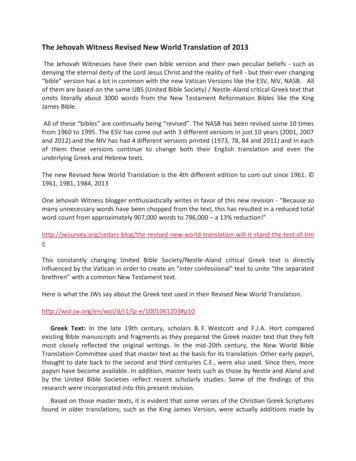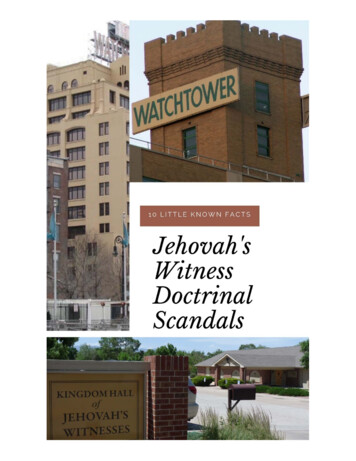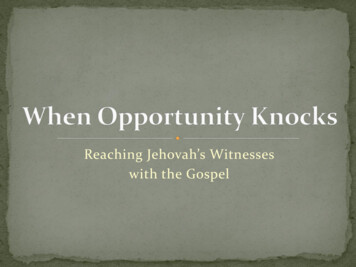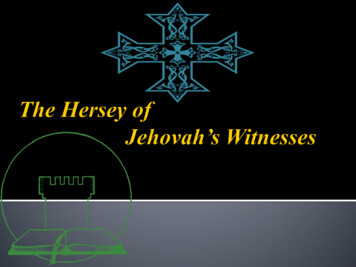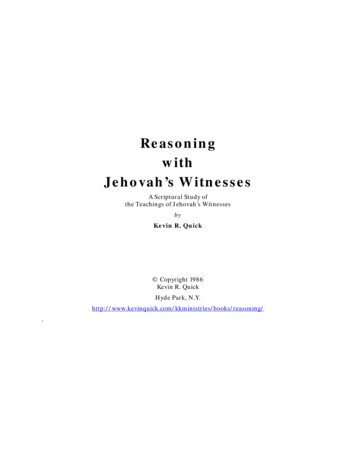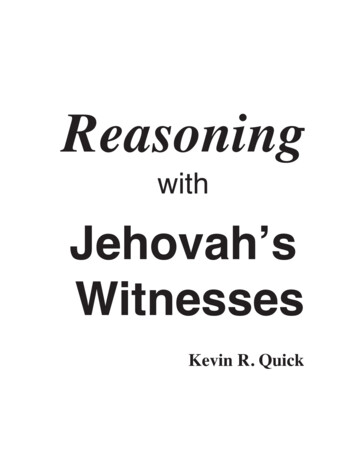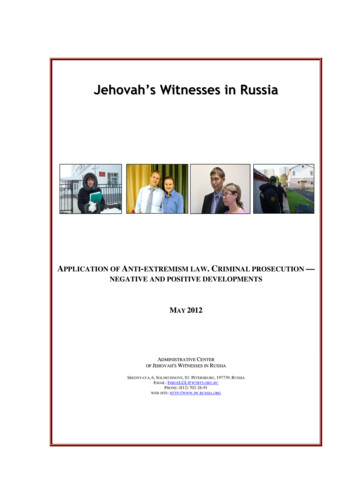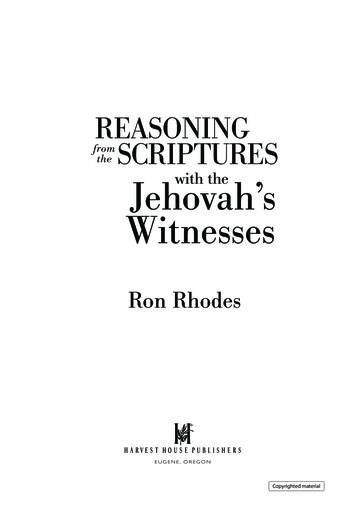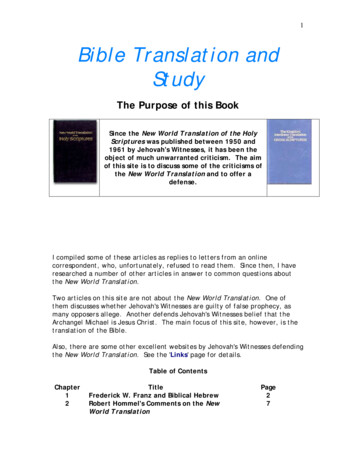
Transcription
Jehovah’s Witnessesin Europe
Jehovah’s Witnessesin EuropePast and Present Volume I/1Edited byGerhard Besier and Katarzyna Stokłosa
Jehovah’s Witnesses in Europe: Past and Present Volume I/1Edited by Gerhard Besier and Katarzyna StokłosaThis book first published 2016Cambridge Scholars PublishingLady Stephenson Library, Newcastle upon Tyne, NE6 2PA, UKBritish Library Cataloguing in Publication DataA catalogue record for this book is available from the British LibraryCopyright 2016 by Gerhard Besier, Katarzyna Stokłosaand contributorsAll rights for this book reserved. No part of this book may be reproduced,stored in a retrieval system, or transmitted, in any form or by any means,electronic, mechanical, photocopying, recording or otherwise, withoutthe prior permission of the copyright owner.Cover images:Branch office of Jehovah’s Witnesses in Paris (105, rue des Poissonniers);Natzweiler Struthof concentration camp;The “Kindergarten” in the Świeradów-Zdrój (Flinsberg) camp.By courtesy of Célestin Floryn, Raymond Federspiel and Jehovah’sWitnesses, FranceCover design: Damián di Carlo, Sarah-Elena KlaassenISBN (10): 1-4438-9445-1ISBN (13): 978-1-4438-9445-6As a two-volume set:ISBN (10): 1-4438-9726-4ISBN (13): 978-1-4438-9726-6
ContentsList of Figures. VIIList of Tables. IXList of Charts.XIntroduction. 1Jehovah’s Witnesses in Western and Southern EuropeGerhard Besier & Katarzyna StokłosaBelgium. 13A History of Jehovah’s Witnesses in BelgiumWilly Fautré1. Jehovah’s Witnesses Before World War I2. Jehovah’s Witnesses Between the Wars3. World War II: Jehovah’s Witnesses Resist Nazi Occupation4. Free Once More5. Social Hostility – An Overview (1945–2010)6. Conclusion7. Bibliography Specific to the Religious Association of Jehovah’s Witnesses14151725404446France. 47Jehovah’s Witnesses in Twentieth-Century FranceRégis Dericquebourg1. The First Proclaimer in France2. Why Did Polish-Catholic Immigrants Become Jehovah’s Witnesses?3. Jehovah’s Witnesses Grow in Number4. Kingdom Hall Construction Makes Progress in France5. Problems Arise6. Jehovah’s Witnesses – From “Sect” to Denomination?7. Conclusion8. Bibliography Specific to the Religious Association of Jehovah’s Witnesses4751545666717981France and Luxembourg. 86“And Suddenly the Germans Were Here”The Persecution of Jehovah’s Witnesses in France and LuxembourgAngela Nerlich1. Early Beginnings in France2. The First World War8688
VIContents3. After the Great War4. Dark Clouds on the Horizon by 19325. After Hitler’s Takeover6. After the Outbreak of World War II7. The German Offensive in the West8. Jehovah’s Witnesses in “Gau Westmark”9. Statistics10. Short Biographies and Case Studies11. Liberation12. Epilogue13. Bibliography Specific to the Religious Association of Jehovah’s Witnesses91100102113115122130141274275287Greece. 289Jehovah’s Witnesses in Greece – A History of EnduranceAthanasios Reppas & Timotheos Sigalas1. Background Information and Overview2. Proselytism3. Places of Worship4. Conscientious Objection5. Family Life6. Employment7. Education8. Epilogue9. Bibliography Specific to the Religious Association of Jehovah’s Witnesses290292295297302307310312315Spain. 319Jehovah’s Witnesses During Franco’s DictatorshipKatarzyna Stokłosa1. Appendix2. Bibliography Specific to the Religious Association of Jehovah’s Witnesses338349Notes on Contributors. 353List of Abbreviations. 355
List of FiguresBelgium1-1Saint-Gilles prison in Brussels.191-2Natzweiler-Struthof concentration camp in Alsace.201-3Marie Floryn in Ravensbrück, 1942.221-4Léon and Marie Floryn.221-5Jehovah’s Witnesses in Saint-Hubert prison, -1Map of Kingdom Halls in France.582-2Map of French urban centres.582-3Salle du Royaume (Kingdom Hall) – Carpentras.632-4Salle du Royaume (Kingdom Hall) – Mauguio.642-5Branch office/Bethel of Jehovah’s Witnesses in Louviers.65France and nch office at 105, rue des Poissonniers, Paris.963-2Convention at “Salle Pleyel” in Paris, 1931.993-3The small group of Witnesses in Esch-sur-Alzette, 1940.1183-4“Schutzhaftbefehl” (protective custody order) for Rosalie Fonck, 1940.1423-5Wedding photograph of Nicolas and Ketty Federspiel, mid-1920s.1443-6Nicolas Federspiel’s prisoner personnel card, Buchenwald.1453-7The “Kindergarten” in the Świeradów-Zdrój (Flinsberg) camp.1473-8Raymond Federspiel in the Świeradów-Zdrój camp.1483-9Ketty Federspiel and her children, 1943.1493 - 10Bardo (Wartha) resettlement camp, 1944.1503 - 11Jean Queyroi.1623 - 12Vinko Platajs and his wife Josephine.1723 - 13“Stuttgarter NS-Kurier” reporting on the trial of Fritz Hentz and others.2033 - 14Kornelia Kucińska.2243 - 15Marcel Sutter shortly before he was executed.2473 - 16Death sentence for Marcel Sutter, page 1.2483 - 17Death sentence for Marcel Sutter, page 2.2493 - 18Death sentence for Marcel Sutter, page 3.2503 - 19“Rue Antoine Freyermuth” in Strasbourg.2563 - 20Werner Gaßner.2593 - 21Farewell letter from Heinrich Kurlbaum, 1944.263
VIIIFig.Fig.Fig.Fig.Fig.Fig.Fig.List of Figures3 - 22Drawing by Heinrich Kurlbaum.2633 - 23“Heinrich-Kurlbaum-Weg” in Minden.2653 - 24Leonhard Jürgen.2683 - 25Leonhard’s note for his mother.2693 - 26Albin Relewicz’s accusation, Metz, 1943.2733 - 27The official gazette “Mémorial” publicly announcing the legal registration ofthe “Watch Tower Bible & Tract Society” in Luxembourg.2763 - 28Léon Blum’s letter supporting the legal reregistration of Jehovah’s Witnessesin 1Minos Kokkinakis and his wife.2944-2Plato Idreos speaking at an assembly in the woods, 1970.2974-3Ioannis Tsoukaris shortly before his execution.2984-4Religious conscientious objectors in prison.2994-5Vassilis Karafatsas.2994-6John Karabakakis behind bars, 1975.3004-7Jehovah’s Witnesses imprisoned on the island of Cos.3014-8Branch office of Jehovah’s Witnesses in .Fig.Fig.Fig.Fig.Fig.Fig.Fig.Fig.Fig.5-1Fernando Marín, 2010.3265-2Francisco Moreno in military prison, 1969.3275-3Santa Catalina military prison in Cádiz, 1967.3285-4Jesús Martín Nohales, 1959 and 2010.3295-5Ángel F. Sánchez Morín, 1971 and 2010.3305-6The dormitory in the Santa Catalina prison, 1974.3315-7Police record from Reformatorio de Adultos, Ocaña, Toledo, 1959.3385-8Police record of a prison sentence, Vicisitudes, 1959.3395-9Police record of the individual and his activities, Vicisitudes, 1959.3405 - 10Police record no. 19427, personal details, fingerprints, 1960.3415 - 11Police record no. 19427, description of activities, 1960.3415 - 12Police record no. 54330, personal details and fingerprints, 1961.3425 - 13Letter from the Civil Government of Zaragoza, 1973.3435 - 14Reply from the chief inspector of Zaragoza, 1973.3445 - 15Reply from the chief of police of Zaragoza, 1973.3455 - 16Programa para la Asamblea de Circuito de los Testigos de Jehová, 1973.3465 - 17Letter from the Civil Government of Zaragoza, 1975.3475 - 18Letter from the Civil Government of Zaragoza, 1976.348
List of TablesFrance2-1Number of Jehovah’s Witnesses in France since 1951.562-2Number of building projects in relation to growth figures.60TableFrance and LuxembourgTable3-1Development of Jehovah’s Witnesses in France and in the Saar Region,1932–1936.107Prison detentionTableTable3-2Key data about French prisoners.1643-3Key data about prisoners born in Alsace.168Camp detentionTable3-4French prisoners deported to Groß-Rosen.1833-5French prisoners deported to Ravensbrück – table 1.1873-6French prisoners deported to Ravensbrück – table 2.1873-7French prisoners deported to Schirmeck.1893-8German prisoners born in France.2023-9German prisoners that lived in France.2053 - 10German prisoners transferred to French concentration camps from abroad.2053 - 11Polish prisoners.2213 - 12Dutch prisoners.2283 - 13Austrian prisoners.2293 - 14Stateless prisoners.2353 - 15Baubrigade (Construction Brigade) bleTableTableDeath toll3 - 16French prisoners.2443 - 17German prisoners.2573 - 18Polish prisoners.2673 - 19Austrian prisoners.270TableTableTableSpainTable5-1Kingdom Halls of Jehovah’s Witnesses in the Provinces, 1975.332
List of ChartsFrance2-1Number of Jehovah’s Witnesses in relation to the number of attendees at theMemorial celebration (Passover).552-2Logarithmic representation of growth figures.55ChartFrance and tal number persecuted by the Nazis according to national group.1333-2Total number of fatalities according to national group.1333-3Total number of victims never imprisoned according to national group.1343-4Total number imprisoned according to national group.1343-5Total number of minors according to national group.1373-6Total number of minors according to their Nazi persecution.1373-7Total number of conscientious objectors according to national group.139
IntroductionJehovah’s Witnesses in Western andSouthern EuropeGerhard Besier & Katarzyna StokłosaThe religious community of Jehovah’s Witnesses began during the GreatAwakening in nineteenth-century America. Most “awakened” communitieswere splinter groups of established Protestant religions that favoured congregational independence. Similar to the Reformation of the sixteenth century, the religious awakening was seen as a reaction against rigid churchdoctrine, the perception of apostasy, the loss of any real eschatological expectations and the lack of charismatic inspiration.1The religious group that became known as Jehovah’s Witnesses wasfounded by clothing salesman Charles Taze Russell (1852–1916), fromAllegheny near Pittsburgh, Pennsylvania. He was raised a Presbyterianand joined the Congregational Church at age fourteen. In 1870, Russell attended a service conducted by Second Adventists, who believed that JesusChrist would visibly return in 1874. As a result, he and a few close associatesfounded a Bible study group in Pittsburgh. Their objective was to examineboth the Old and New Testaments to learn more about Christ’s return. In1876, Russell met Nelson H. Barbour, the leader of a small group of formerSecond Adventists in Rochester, New York. In his periodical, “Herald ofthe Morning,” Barbour explained that Jesus had not been visibly present onearth since 1874, but invisibly present. In 1877, they co-authored a book expressing the view that Christ’s invisible presence marked the beginning of aforty-year period of harvesting and judgment that would culminate in 19141. Cf. Ernst Benz, Kirchengeschichte in Ökumenischer Sicht [Church History froman Ecumenical Viewpoint], Leiden-Cologne 1961, 75–111.
2Introductionwith the establishment of “God’s Kingdom.” Proclaimers of this news wouldthen be glorified, that is, taken into the Kingdom of Heaven.In 1879, Russell began publishing his own monthly magazine entitled“Zion’s Watch Tower and Herald of Christ’s Presence.” In 1881, he founded“Zion’s Watch Tower Tract Society” in Pittsburgh, which was registered in1884 as a non-profit corporation in the state of Pennsylvania. In 1896, thename was changed to “Watch Tower Bible and Tract Society,” and againin 1955 to “Watchtower Bible and Tract Society of Pennsylvania.” From1886 to 1904, Russell penned his six-volume masterpiece “Studies in theScriptures.” Beginning in 1891, he made twelve trips to Europe. In 1900,the first branch office outside the United States was opened in London. In1897, the first German issue of “Zion’s Watch Tower and Herald of Christ’sPresence” was shipped to Europe via a literature depot in Berlin. The depot was later moved to Bremen. In 1902, the German branch office wasopened in Wuppertal-Elberfeld and moved to Magdeburg in 1923. Theworld headquarters had already been moved in 1909 from Pittsburgh toBrooklyn, New York, and by 1914 Jehovah’s Witnesses were present in 68countries, spanning all continents. In many of those countries, a branch office was established.After Russell’s death in 1916 and the internal dissension that followed,he was succeeded by his former legal adviser, Joseph Franklin Rutherford(1869–1942). During the First World War, the Bible Students’ (as they calledthemselves) view of military conscription varied according to each one’spersonal understanding of Christian neutrality and Christian obedience.Some adopted a strictly neutral position and categorically refused all formsof military service; others opted to serve in medical departments or hospitals; and still others performed military service but refused to bear arms. Inthe United States, those taking the spiritual lead among the Bible Studentswere falsely accused of conspiracy in 1918 and sentenced to lengthy prisonterms in Atlanta, Georgia. But in 1919, the judgments were overturned andthe prisoners were released. In the 1920s, the Bible Students came to newlyunderstand the role of governments: they belong to a part of the world thatis invisibly ruled by Satan (1 John 5:19; John 12:31). In July 1931, duringa convention in Columbus, Ohio, the Bible Students adopted the name“Jehovah’s Witnesses,” which they based on Isaiah 43:10.From 1932 to 1938, Rutherford directed a restructuring programme tocentralise and streamline the religious organisation. Among other things,“elected elders” were replaced by “service committees.” These committees supported a local overseer that was appointed by headquarters. The“Governing Body” in Brooklyn acted as Jehovah’s channel. According to
Introduction3their understanding, the community was a “theocratic organisation” thatserved as “God’s channel of communication” to announce “God’s message”of the upcoming “new world.” The Rutherford era saw the introduction oflarge conventions and statistical reports on the evangelising work, as well asthe establishment of local meeting places known as “Kingdom Halls.”When Rutherford died in 1942, Nathan Homer Knorr (1905–1977) succeeded him as president. In 1943, he launched the “Theocratic MinistrySchool” and all believers could enrol. In 1959, he set up a training programme for those who wish to take on additional responsibilities in thereligious association, known as the “Kingdom Ministry School.” In 1962,Jehovah’s Witnesses acknowledged that governments play an additionalsecond role: they constitute the “superior authorities” that God’s allows toexist and to which Christians must subject themselves (Romans 13). Underthe presidency of Knorr, who was a skilled organiser, Jehovah’s Witnessesbecame a worldwide religious denomination with over two million members(1977). After Knorr’s death, vice president Frederick W. Franz (1893–1992)took the lead in the organisation. In 1966, Franz co-authored the book “LifeEverlasting – In Freedom of the Sons of God,” which identified the year1975 as the end of six thousand years of human existence. Franz was succeeded by Milton G. Henschel (1920–2003), who served as the new president (until 2000).Until 2000, Governing Body members occupied administrative positions(e.g. the presidency) in the legal corporations used by the religious community. In October 2000, however, they resigned from the boards of all legalentities. This was to emphasise that positions within the legal framework ofJehovah’s Witnesses do not correspond to any spiritual hierarchy.By adopting the name “Jehovah’s Witnesses,” the community sought toindicate that above all else they (following Jesus’ example) are witnessesof Jehovah God. They are thus part of a long line of faithful witnesses thatbegan with Abel and reaches up to the present. The “great apostasy” fromthe pure worship of Jehovah had started early in the history of Christianity(according to their interpretation). Because of such apostates, “the Kingdomwas shifted from heaven to earth. [ ] pagan doctrines continued to infiltrate Christianity.”2 Among the teachings identified by Jehovah’s Witnessesas false was the Trinity doctrine. It was rejected as unscriptural. As the on2. WTS (ed.), Jehovah’s Witnesses – Proclaimers of God’s Kingdom, Brooklyn, NewYork 1993, 33, 38. Jehovah’s Witnesses are not alone in viewing the entire organisedchurch structure as apostasy. The concept is common in Christianity; cf. Rudolf Sohm,Wesen und Ursprung des Katholizismus [The Nature and Origin of Catholicism],Leipzig ²1912. The actual idea of religious degeneration has pre-Christian origins.
4Introductionly-begotten Son of God, Jesus Christ is the second greatest personage inthe universe and therefore subordinate to God. Because he was faithful tohis commission to bear witness, he died on a “torture stake” and Jehovahrewarded him with immortality in a spiritual body and kingship in heaven.Jehovah’s Witnesses believe that Christ has been exercising rulership fromheaven since 1914. The “Holy Spirit” is Jehovah’s impersonal force throughwhich he operates and accomplishes his will (Genesis 1:2).Jehovah’s Witnesses base their teachings solely on the Bible, considering it the written Word of God. Beginning with Moses, forty human writerswere commissioned to record God’s message to mankind over a period of1,600 years. The Bible therefore does not contradict itself and is completely true and accurate down to the minutest detail. It teaches what Jehovah’sWitnesses must do to please God and receive eternal life, either on a paradise earth or in the heavenly realm. The Bible also reveals God’s purpose formankind and enables man to calculate when certain events will occur.Before the thousand-year reign of peace (Millennium), Jesus Christ, supported by a heavenly army of angels, will fight a final apocalyptic battleagainst the powers opposing God (battle of “Armageddon”; see Revelation16:16), in which the earth will be cleansed of all wickedness.3 Jehovah’sWitnesses will merely spectate in this conflict. After Armageddon, the greatmajority of Witnesses will remain on earth in a newly established paradise,while a small group – the 144,000 anointed spiritual brothers of Christ – willreign with Christ as kings and priests in heaven. The 144,000 are comprisedof faithful individuals who have already died and been raised to life as spiritcreatures in heaven, along with a “remnant” that are still on the earth today.There is no precise information as to when Armageddon will occur.Certain calculations that pinpointed 1914, 1925 and 1975 were incorrect.Accordingly, as in previous millenarian movements, these “delays” resultedin membership losses and splinter groups.Jehovah’s Witnesses earnestly wish to abide by all Biblical commandsand laws. In view of this, they obey God’s command to Noah to abstain fromblood (Genesis 9; Leviticus 17; cf. Acts 15). This refers not only to foodbut also to blood transfusions. Organ transplants are a matter of individualconscience.4 Although Jehovah’s Witnesses obey the law, pay taxes, complywith compulsory schooling, etc., they remain apolitical (they refuse military service, do not participate in political elections and do not join political3. Cf. Brockhaus-Enzyklopädie [Brockhaus Encyclopaedia], 19th Edition, Vol. 9,487; Evangelisches Lexikon für Theologie und Gemeinde [Evangelical Dictionaryof Theology and Churches], 2nd Edition, Vol. 2, 849.4. Cf. WTE 101 (6), 15 Mar. 1980, 31.
Introduction5parties). Refinements in teaching have been made regarding their distinctrefusal to perform alternative service when it indirectly supports the military.Recently, however, this has become less of an issue because of the increasingshift from conscription to all-volunteer professional armies. Popular annualfestivities, Christian holidays (e.g. Christmas, Easter, Whitsun), and personal celebrations (birthdays) are rejected as unscriptural, but family celebrations such as wedding anniversaries are not subject to such censure. Theircongregational life consists of regular meetings two days a week (includingthe “Watchtower Study,” “Theocratic Ministry School” and “CongregationBible Study”), evangelising to people of other faiths (“preaching”), as wellas many different social appointments, celebrations, sports and excursions.In serious cases of ethical misconduct or doctrinal deviation, members aregiven counsel. In the rare event5 that an individual stubbornly persists in sucha course, a “judicial committee” is formed to examine the situation. Shouldthe individual fail to repent, it may become necessary to disfellowship himfrom the congregation. However, once such a person recognises his wrongdoing, he may apply for reinstatement. Approximately one third return.Adults and adolescents enter into the community of Jehovah’s Witnessesthrough baptism, which involves complete immersion in water. Being submerged symbolises death to one’s former life course and being raised upfrom the water denotes a new personal dedication to God; subordinatingone’s own free will to Jehovah’s will. Any previous baptism in anotherChristian church is not recognised. Baptisms are usually performed in a baptismal pool during larger gatherings of Jehovah’s Witnesses at the circuit orregional level. Once a year on the 14th day of Nisan (according to the Jewishreligious calendar), Jehovah’s Witnesses observe a “Memorial” to commemorate the death of Jesus Christ. Only members of the “little flock” – the “remnant” of the 144,000 who will co-reign with Christ in heaven as kings andpriests – partake of the bread and wine.Similar to Lutheran churches that keep a count of their confirmed members, Jehovah’s Witnesses publish the number of active members (“publishers”). The “2015 Yearbook of Jehovah’s Witnesses” records that 8,201,545“publishers” were actively evangelising in some 239 countries in 2014. Thenumber of active members and interested associates is now reaching the 20million mark (19,950,019 attended the Memorial in 2014).Local groups of Jehovah’s Witnesses are called “congregations”; approximately 20 congregations form a “circuit.” A committee known as the5. Cf. Rodney Stark/Laurence R. Iannaccone, Why the Jehovah’s Witnesses Growso Rapidly: A Theoretical Application, in: Journal of Contemporary Religion, 12/2(1997), 136.
6Introduction“Governing Body” serves at the world headquarters in New York Stateand provides spiritual oversight for the worldwide activities of Jehovah’sWitnesses. In recent years, several branch offices have been merged, including those in Luxembourg, Austria, Switzerland and Liechtenstein. The workin these lands is now supervised from the Central European “Bethel” (Houseof God) in Selters, near Frankfurt. This branch office carries out numerousservices for the now enlarged branch area, such as printing literature. Thereligious community has thus reverted back to its old organisational structure – a Central European office, which in former times was based in Bern.Jehovah’s Witnesses refer to other churches and denominations collectively as “the Harlot Babylon” – a term used in the Bible at Revelation17. In making such a judgment, they follow the condemnatory traditions ofProtestantism. In the eighteenth century, many Protestants rejected certaininstitutionalised forms of Christianity (that sprang from the
A History of Jehovah’s Witnesses in Belgium Willy Fautré 1. Jehovah’s Witnesses Before World War I 14 2. Jehovah’s Witnesses Between the Wars 15 3. World War II: Jehovah’s Witnesses Resist Nazi Occupation 17 4. Free Once More 25 5. Social H

